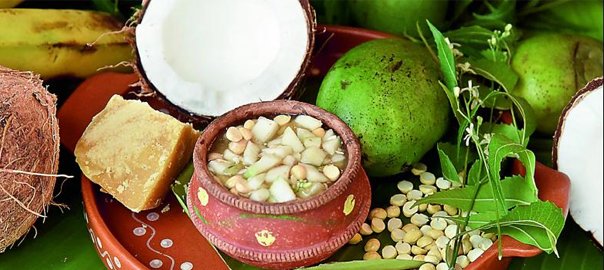People across culture and countries celebrate the New Year in keeping with their tradition and culture. In India, Yugadi (Ugadi in Kannada) is the beginning of a new year according to Chandramana(Lunar measure). It is said that the epoch (Yuga) began on the first day of the Chaitramasa. Hence, the name Yugadi or the day of a new Yuga came into vogue. It is called as Samvatsara-Arambha. In the Indian Almanac, there are 60 such Samvatsaras and the cycle gets repeated every 60 years.
Yugadi is also the beginning of Vasanta Ritu or the spring season. Hence, it is a surge of new energy in nature and also promotes a positive energy in all the living beings. In India, people traditionally take bath by applying oil, known as ‘Abhyanjanam’ on this day. It is just like the bath, taken on the ‘Deepavali’ day. Various aromatic herbs are also used to rejuvenate the skin and also to kinder fresh life.
The oil is offered to Lord with the following Mantra:
Praptesmin vatsare nityam madgruhe mangalam kuru|
Then, oil is smeared upon with the following Mantra:
Taile LakshmiH Jale GangA VatsarAditithau Shubhe|
AlakshmiparihArArtham MangalasnAnamAcharet||
There is a special reason for this Abhyanjanam (oil ritual). It is believed that Goddess Lakshmi resides in the oil and takes away all the blemishes and give fresh life. Goddess Ganga resides in the water and purifies. By performing the oil bath, it is stated in the scriptures that all poverty would be removed.
After the bath, new clothes are adorned and the Lord is worshipped at home. Elders are paid salutations and their good wishes are sought after. In some places, people worship a flag which is named, ‘Indra Dhwaja’. After worshipping, it is hoisted to signify victory over all the obstacles.
The most important part of the Yugadi celebration is the partaking of Neem (Azadiracta) and Jaggery (unrefined cane sugar) known in local parlance as ‘Bevu-Bella’. Both are pounded in equal measure along with small quantity of pepper, cardamom, salt, tamarind combined with pieces of mango. It is also called Yugadi Pachadi. It is offered to Lord and is given to all elders and consumed by all.
Symbolically, the neem signifies sorrow and Jaggery signifies happiness. It shows that our life is a combination both sorrow and happiness. Hence, we should take and treat both sorrow and happiness equally in our life. Pepper represents anger, salt represents fear, tamarind show disgust and mango shows enthusiasm. All these are part and parcel of life.
The following Mantra has to be chanted while consuming the ‘Bevu-Bella’:
SatAyurvajradehaya sarvasampatkarAyacha|
SarvArishtavinAshAya nimbakadalabhakshaNam||
(Consuming neem and Jaggery brings a robust health to the body, bestows wealth and removes all evil effects)
In the evening, a Pandit or Purohit (scholar) is invited to give a summary of New Samvatsara’s Panchangam events. This is called “Panchanga Shravanam”. The details of the forthcoming festivals, eclipse, auspicious dates, muhurtams and predictions in general are read out from the Panchangam by the Pundit. Finally, the Panchangam is decorated with flowers and Mangalarathi is offered. Thus, the Yugadi is the very first festival that is celebrated and the good of the entire world is prayed.
||Sarve janAH sukhinO Bavantu||
Pureprayer is a leading App based and web based platform offering Puja-Homa-Pariharas and SpiRitual Journeys-Darshan and Puja packages to several important holy and sacred destinations.
Please visit our website www.pureprayer.com or call us on +91 8151002255, WA No: +91 9900821000 to learn more.
Please visit our Pureprayer facebook page to follow us and discover more.


Leave a review